Foothills Fancies now has a companion blog. If you find you "just have to" have more to read than these short pieces, look for a link at the end of the posts to go to full length nature essays on similar topics. In the 1990s, I wrote a monthly nature column for local publications, and have finally figured out how to post some of these without clogging Foothills Fancies.
Thanks go to Linda Kirkpatrick of Upbeat for publishing more than 30 of these and to Jan Ratcliffe for her excellent pen-and-ink illustrations every month. It was a delightful project I'd like to tackle again; guess blogging is my way of doing that.
For now, an essay post is linked from Foothills Roses (see May 29). I'll go back through old posts this week and make a few new connections for previous posts where possible.
Monday, May 29, 2006
More Foothills Roses
Yes, they're all roses, and all have white flowers. But you can tell them apart! Give it a try:
 Longfellow says the Hawthorn buds "ope in the month of May." And he's right! Thorny as their name suggests, these foothills natives often grow in impenetrable thickets along streams and gullies. The dry fruits resemble rose hips, and, though usable in jams, are more tempting to birds and bears than to the rest of us. Note that the glossy leaves and innocent flowers develop simultaneously, making a striking white-on-green composition. Equally lovely, when the fruits mature, is their red-on-green effect against the leaves. Stop in later for fall color. In our area, Crategus erythropoda, Crategus macrantha (formerly C. occidentalis).
Longfellow says the Hawthorn buds "ope in the month of May." And he's right! Thorny as their name suggests, these foothills natives often grow in impenetrable thickets along streams and gullies. The dry fruits resemble rose hips, and, though usable in jams, are more tempting to birds and bears than to the rest of us. Note that the glossy leaves and innocent flowers develop simultaneously, making a striking white-on-green composition. Equally lovely, when the fruits mature, is their red-on-green effect against the leaves. Stop in later for fall color. In our area, Crategus erythropoda, Crategus macrantha (formerly C. occidentalis).
 A smaller shrub, often equally thorny, is the American Plum. As shown here, with leaves just expanding, the flowers are past prime. So when the flowers first open, branches are bare, making this an easy rose to identify long distance! The large fruits are much enjoyed by birds, bears, even coyotes. Prunus americana.
A smaller shrub, often equally thorny, is the American Plum. As shown here, with leaves just expanding, the flowers are past prime. So when the flowers first open, branches are bare, making this an easy rose to identify long distance! The large fruits are much enjoyed by birds, bears, even coyotes. Prunus americana.
 One final Rose for today, the Serviceberry. Equally tasty (probably more so to humans) and less thorny, these are also found in the rosy thickets of foothills canyons. Fruits, this time, look more like blueberries than anything else. Best distinction, I think, is the smooth, round leaves, jagged only on the outer edge, and an unusual smooth purplish bark. Amelanchier alnifolia.
One final Rose for today, the Serviceberry. Equally tasty (probably more so to humans) and less thorny, these are also found in the rosy thickets of foothills canyons. Fruits, this time, look more like blueberries than anything else. Best distinction, I think, is the smooth, round leaves, jagged only on the outer edge, and an unusual smooth purplish bark. Amelanchier alnifolia.
More on native shrubs in the Rose Family.
 Longfellow says the Hawthorn buds "ope in the month of May." And he's right! Thorny as their name suggests, these foothills natives often grow in impenetrable thickets along streams and gullies. The dry fruits resemble rose hips, and, though usable in jams, are more tempting to birds and bears than to the rest of us. Note that the glossy leaves and innocent flowers develop simultaneously, making a striking white-on-green composition. Equally lovely, when the fruits mature, is their red-on-green effect against the leaves. Stop in later for fall color. In our area, Crategus erythropoda, Crategus macrantha (formerly C. occidentalis).
Longfellow says the Hawthorn buds "ope in the month of May." And he's right! Thorny as their name suggests, these foothills natives often grow in impenetrable thickets along streams and gullies. The dry fruits resemble rose hips, and, though usable in jams, are more tempting to birds and bears than to the rest of us. Note that the glossy leaves and innocent flowers develop simultaneously, making a striking white-on-green composition. Equally lovely, when the fruits mature, is their red-on-green effect against the leaves. Stop in later for fall color. In our area, Crategus erythropoda, Crategus macrantha (formerly C. occidentalis). A smaller shrub, often equally thorny, is the American Plum. As shown here, with leaves just expanding, the flowers are past prime. So when the flowers first open, branches are bare, making this an easy rose to identify long distance! The large fruits are much enjoyed by birds, bears, even coyotes. Prunus americana.
A smaller shrub, often equally thorny, is the American Plum. As shown here, with leaves just expanding, the flowers are past prime. So when the flowers first open, branches are bare, making this an easy rose to identify long distance! The large fruits are much enjoyed by birds, bears, even coyotes. Prunus americana. One final Rose for today, the Serviceberry. Equally tasty (probably more so to humans) and less thorny, these are also found in the rosy thickets of foothills canyons. Fruits, this time, look more like blueberries than anything else. Best distinction, I think, is the smooth, round leaves, jagged only on the outer edge, and an unusual smooth purplish bark. Amelanchier alnifolia.
One final Rose for today, the Serviceberry. Equally tasty (probably more so to humans) and less thorny, these are also found in the rosy thickets of foothills canyons. Fruits, this time, look more like blueberries than anything else. Best distinction, I think, is the smooth, round leaves, jagged only on the outer edge, and an unusual smooth purplish bark. Amelanchier alnifolia.More on native shrubs in the Rose Family.
Sunday, May 28, 2006
Feathery "Fake Firs"
Not the "real" thing, but real in their own right, certainly, Douglas-firs confused botanists for a long time after they were discovered by western science. Collected in 1792 somewhere in the Pacific Northwest, they were first thought to be pines, spruces, or firs. In fact, Douglas-fir is in a class by itself, and 75 years later botanists gave it a new genus name. For our species, they settled on Pseudotsuga menziesii in honor of its discoverer, Scottish naturalist Archibald Menzies.
 On our hike at Eldorado Canyon May 7th, I saw these early cones, seemingly for the first time. More likely I never paid attention before, but the deep magenta female cones just jumped out at me this time. Tiny prototypes of the finished "fruits," these are probably still awaiting fertilization by pollen from the orangish male cones also visible in this photo.
On our hike at Eldorado Canyon May 7th, I saw these early cones, seemingly for the first time. More likely I never paid attention before, but the deep magenta female cones just jumped out at me this time. Tiny prototypes of the finished "fruits," these are probably still awaiting fertilization by pollen from the orangish male cones also visible in this photo.
 Just across the trail, same day but in a sunnier spot, cone development was much more advanced. I'm not sure with Doug-fir, but some conifers take years to mature their cones. These, I'd guess, ripen from birth to seed in one season.
Just across the trail, same day but in a sunnier spot, cone development was much more advanced. I'm not sure with Doug-fir, but some conifers take years to mature their cones. These, I'd guess, ripen from birth to seed in one season.
As always, click on the picture for a closer view. More on Douglas-fir here.
 On our hike at Eldorado Canyon May 7th, I saw these early cones, seemingly for the first time. More likely I never paid attention before, but the deep magenta female cones just jumped out at me this time. Tiny prototypes of the finished "fruits," these are probably still awaiting fertilization by pollen from the orangish male cones also visible in this photo.
On our hike at Eldorado Canyon May 7th, I saw these early cones, seemingly for the first time. More likely I never paid attention before, but the deep magenta female cones just jumped out at me this time. Tiny prototypes of the finished "fruits," these are probably still awaiting fertilization by pollen from the orangish male cones also visible in this photo. Just across the trail, same day but in a sunnier spot, cone development was much more advanced. I'm not sure with Doug-fir, but some conifers take years to mature their cones. These, I'd guess, ripen from birth to seed in one season.
Just across the trail, same day but in a sunnier spot, cone development was much more advanced. I'm not sure with Doug-fir, but some conifers take years to mature their cones. These, I'd guess, ripen from birth to seed in one season.As always, click on the picture for a closer view. More on Douglas-fir here.
Saturday, May 27, 2006
Bee Heaven
Our story today dates to the Red Rocks Park hike on May 16th. Can a shrub be a "wildflower"? Today's pick is Chokecherry, so see what you think.
 Many of our flowering foothills shrubs are in the Rose Family, and Chokecherry is among the most abundant. It's distinguished in the field by its elongated inflorescences and flowers that come after the leaves.
Many of our flowering foothills shrubs are in the Rose Family, and Chokecherry is among the most abundant. It's distinguished in the field by its elongated inflorescences and flowers that come after the leaves.
Note that there's a honeybee nectaring on these fragrant flowers (and a smaller bee or wasp behind him waiting its turn). Honeybees are, of course, amazing pollinators, and not only produce honey for human (and bear) consumption, but also ensure the fruitfulness of many other crops. They are, in fact, domesticated servants of humans.
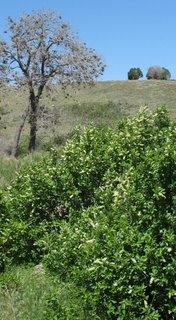 Turns out, just around the corner from this bush is a bee tree. Don't think I'd noticed the hive in this hollow Hackberry before as I'm usually drawn to the witches' broom decorating its branches, but Bee Lady was with me and she pointed it out. The Hackberry is not dead-- yet! These trees are normally very late to leaf out, and it has been weakened considerably by the witches' broom.
Turns out, just around the corner from this bush is a bee tree. Don't think I'd noticed the hive in this hollow Hackberry before as I'm usually drawn to the witches' broom decorating its branches, but Bee Lady was with me and she pointed it out. The Hackberry is not dead-- yet! These trees are normally very late to leaf out, and it has been weakened considerably by the witches' broom.
Looks like bee heaven to me-- a very short trip from a productive stand of Chokecherry to home and safety in the nearby tree. Foraging just a little further afield will enable these bees to find many more "roses" to pollinate. Our foothills shrubs surely benefit from all this attention!
[I have a nice picture of two bees heading into the tree home, but blogger insists on displaying it sideways. Sorry!]
Here's the rub (why must all our fine ecological stories seem to have a rub?): I learned, or was reminded, last week that our beloved honeybees were interlopers in this country, coming along with European settlers and even leading the way into the wilderness. It is said that the Amerindians were saddened when they saw the bees, because they knew the white man would soon follow.
 Many of our flowering foothills shrubs are in the Rose Family, and Chokecherry is among the most abundant. It's distinguished in the field by its elongated inflorescences and flowers that come after the leaves.
Many of our flowering foothills shrubs are in the Rose Family, and Chokecherry is among the most abundant. It's distinguished in the field by its elongated inflorescences and flowers that come after the leaves.Note that there's a honeybee nectaring on these fragrant flowers (and a smaller bee or wasp behind him waiting its turn). Honeybees are, of course, amazing pollinators, and not only produce honey for human (and bear) consumption, but also ensure the fruitfulness of many other crops. They are, in fact, domesticated servants of humans.
 Turns out, just around the corner from this bush is a bee tree. Don't think I'd noticed the hive in this hollow Hackberry before as I'm usually drawn to the witches' broom decorating its branches, but Bee Lady was with me and she pointed it out. The Hackberry is not dead-- yet! These trees are normally very late to leaf out, and it has been weakened considerably by the witches' broom.
Turns out, just around the corner from this bush is a bee tree. Don't think I'd noticed the hive in this hollow Hackberry before as I'm usually drawn to the witches' broom decorating its branches, but Bee Lady was with me and she pointed it out. The Hackberry is not dead-- yet! These trees are normally very late to leaf out, and it has been weakened considerably by the witches' broom.Looks like bee heaven to me-- a very short trip from a productive stand of Chokecherry to home and safety in the nearby tree. Foraging just a little further afield will enable these bees to find many more "roses" to pollinate. Our foothills shrubs surely benefit from all this attention!
[I have a nice picture of two bees heading into the tree home, but blogger insists on displaying it sideways. Sorry!]
Here's the rub (why must all our fine ecological stories seem to have a rub?): I learned, or was reminded, last week that our beloved honeybees were interlopers in this country, coming along with European settlers and even leading the way into the wilderness. It is said that the Amerindians were saddened when they saw the bees, because they knew the white man would soon follow.
Wednesday, May 17, 2006
A Prickly Pair
Monday’s walk at Red Rocks Park was full of flowers. With the late snows delaying the earlier species, and the later ones now beginning to bloom, it seemed like ‘everything’ was flowering at once! Or getting ready to. Shrubs, early and late wildflowers, and even a few cacti. I still haven’t caught up with the photos taken May 7th at Eldorado Canyon, but today we’ll have some fresher ones from Red Rocks, May 15th.
Besides the abundant prickly pear, the foothills offer these two ground-hugging cacti. They can be tricky to tell apart, so let’s take a closer look.
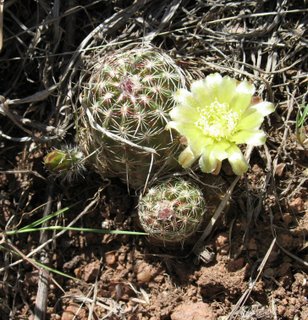 Most common is the “hen and chickens” or “green pitaya,” Echinocereus viridiflorus. (The species name means green-flowered.) It is more likely to grow tall (maybe 4-6 inches) and cylindrical than the second one shown here, and the spines tend to congregate on vertical ridges.
Most common is the “hen and chickens” or “green pitaya,” Echinocereus viridiflorus. (The species name means green-flowered.) It is more likely to grow tall (maybe 4-6 inches) and cylindrical than the second one shown here, and the spines tend to congregate on vertical ridges.
Flowers are just over an inch in diameter, to give you a sense of scale here.
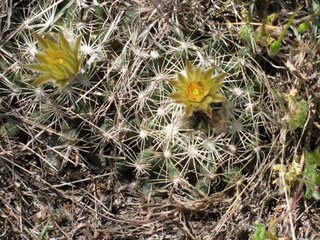 Less often seen, in part because it can be so cryptic, is the nipple cactus, Coryphantha missouriensis. Short and compact, it actually withdraws into the ground a bit during the winter, making it even harder to spot. When in bloom, though, its yellowish flowers give it a little more distinction. The spines occur at the tips of protuberances, hence the name “nipple” cactus. In recognition of this feature, the genus was originally called Mammillaria. A similar species (C. vivipara) has pink flowers and is more unusual in our area.
Less often seen, in part because it can be so cryptic, is the nipple cactus, Coryphantha missouriensis. Short and compact, it actually withdraws into the ground a bit during the winter, making it even harder to spot. When in bloom, though, its yellowish flowers give it a little more distinction. The spines occur at the tips of protuberances, hence the name “nipple” cactus. In recognition of this feature, the genus was originally called Mammillaria. A similar species (C. vivipara) has pink flowers and is more unusual in our area.
Besides the abundant prickly pear, the foothills offer these two ground-hugging cacti. They can be tricky to tell apart, so let’s take a closer look.
 Most common is the “hen and chickens” or “green pitaya,” Echinocereus viridiflorus. (The species name means green-flowered.) It is more likely to grow tall (maybe 4-6 inches) and cylindrical than the second one shown here, and the spines tend to congregate on vertical ridges.
Most common is the “hen and chickens” or “green pitaya,” Echinocereus viridiflorus. (The species name means green-flowered.) It is more likely to grow tall (maybe 4-6 inches) and cylindrical than the second one shown here, and the spines tend to congregate on vertical ridges. Flowers are just over an inch in diameter, to give you a sense of scale here.
 Less often seen, in part because it can be so cryptic, is the nipple cactus, Coryphantha missouriensis. Short and compact, it actually withdraws into the ground a bit during the winter, making it even harder to spot. When in bloom, though, its yellowish flowers give it a little more distinction. The spines occur at the tips of protuberances, hence the name “nipple” cactus. In recognition of this feature, the genus was originally called Mammillaria. A similar species (C. vivipara) has pink flowers and is more unusual in our area.
Less often seen, in part because it can be so cryptic, is the nipple cactus, Coryphantha missouriensis. Short and compact, it actually withdraws into the ground a bit during the winter, making it even harder to spot. When in bloom, though, its yellowish flowers give it a little more distinction. The spines occur at the tips of protuberances, hence the name “nipple” cactus. In recognition of this feature, the genus was originally called Mammillaria. A similar species (C. vivipara) has pink flowers and is more unusual in our area.
Monday, May 15, 2006
Top Ten Reasons to Celebrate Mother's Day
We had, as it turned out, an amazing weekend and a lot to be thankful for. So here’s my list:
- A visit from the Husband’s Mother, otherwise known as MiL, who spent a happy weekend pulling weeds from the patio pavers.
- Knowing that the Other Mother (mine), was safe, well, and reasonably happy at her home on the other side of the Great Divide.
- An absolutely gorgeous weekend, sunny and seasonally warm on Saturday though cooler on Sunday. A weekend to be outside, and we were.
- The arrival, Husband says, of the Bullock's Orioles, one pair streaking through the yard. Our (well, his) first sighting this year, though others have reported them back for several days.
- Not one, but 3, male Black-headed Grosbeaks hanging about to provide company for the females who arrived earlier. We usually get to see the annual babies soon after they fledge.
- A BRAND NEW BIRD in the yard, in fact two or more of them, which are reported below.
- The digital camera, in the temporary absence of the bird book, with which to seek –and instantly get—a correct identification.
- The discovery that our live-in feral cat, Morticia, who escaped on Friday (giving me great cause for alarm), was safe in the garage with Baldur, our current top-of-the-pecking-order male, and the attendant relief when we maneuvered her back into the house last night. (Now if we could just get her fixed!)
- A great hike on Saturday, and making it to the top of North Table Mountain (and down again) in my inadequate condition, without excessive rebellion from my knees—and seeing lots of birds and flowers and no more than eight mountain bikers and (on top anyway) no leafy spurge! Coulda been worse.
- Seeing that almost everything out there comes in pairs, from the bunnies in the yard, to the finches, sparrows, mourning doves, and orioles, to, memorably, the swooping, cavorting pair of Red-tailed Hawks we saw from the rim of North Table Mountain. It is, after all, the Lusty Month of May!

And, Number 11, if I may cheat a bit, ALL THE FLOWERS!! Even without an adequate supply of April showers, or even March snowstorms, we are blessed with blossoms. Our moisture will, at least, get them started—but we’ll need something more to keep them going.
Mystery Bird of the Day
 Truly, I had never seen this one before, and (like my first Western Tanager), I nearly laughed out loud! What a face—unforgettable. I was, of course, convinced it wasn’t a sparrow and was toying with some kind of Longspur, but couldn't put my hands on the bird book. Ah well, never said I was a birder. Shortly after firing a few photos off to Bee Lady, Cat Woman, and Hawkeye, all three answers came back within a half-hour of each other. It was unanimous: the Lark Sparrow.
Truly, I had never seen this one before, and (like my first Western Tanager), I nearly laughed out loud! What a face—unforgettable. I was, of course, convinced it wasn’t a sparrow and was toying with some kind of Longspur, but couldn't put my hands on the bird book. Ah well, never said I was a birder. Shortly after firing a few photos off to Bee Lady, Cat Woman, and Hawkeye, all three answers came back within a half-hour of each other. It was unanimous: the Lark Sparrow.Why here, all of a sudden? Will they stay? And why won't blogger upload the other image without turning it up on end?
There is, apparently, some evidence that bird ranges are shifting. Global warming? Wonder if the real bird folk know? Cat Woman reports that she now sees the occasional Horned Lark, a prairie bird, where she lives higher in the foothills. What else is changing?
Friday, May 12, 2006
More Foothills Gold
Shrubs for All Seasons
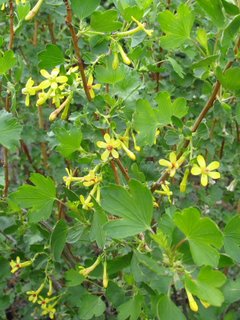 Two colorful native shrubs today offer different approaches to survival here in the foothills. Unlike the foreign ashes, they both came through our recent snows unharmed.
Two colorful native shrubs today offer different approaches to survival here in the foothills. Unlike the foreign ashes, they both came through our recent snows unharmed. Here, Golden Currant (Ribes aureum) shows the strategy of a plant with northern affinities. Like its fellows in the Currant Family, its leaves start early, sometimes even in March, and resist frost. Flowers follow the leaves.
 An alternative method is shown here by Skunkbush, or Three-leaved, Sumac (Rhus trilobata, once R. aromatica), which flowers well before the leaves begin to appear. You can almost see a leaf, just getting started, in the lower right of this photo. The flowers, by the way, are tiny, maybe 3 mm across. The Sumac Family has southern leanings, and our sumacs are cousins of cashews and pistachios.
An alternative method is shown here by Skunkbush, or Three-leaved, Sumac (Rhus trilobata, once R. aromatica), which flowers well before the leaves begin to appear. You can almost see a leaf, just getting started, in the lower right of this photo. The flowers, by the way, are tiny, maybe 3 mm across. The Sumac Family has southern leanings, and our sumacs are cousins of cashews and pistachios. Both these plants are volunteers in my backyard, planted by birds. Both produce small round juicy fruits that birds apparently enjoy and then deposit in likely places. Landscaping made easy!
Thursday, May 11, 2006
Resurrection
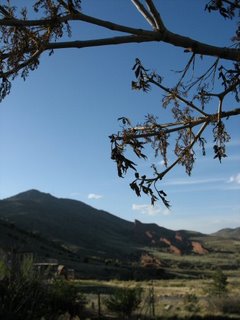 On May 1st, after the "lilac snow" of April 25th, the green ash trees were decidedly not green. They were, in fact, crisp. A beautiful spring day, and all the progress they'd made toward spring was eliminated overnight.
On May 1st, after the "lilac snow" of April 25th, the green ash trees were decidedly not green. They were, in fact, crisp. A beautiful spring day, and all the progress they'd made toward spring was eliminated overnight. Now it's 11 days later and, even for the ashes, spring is returning. The sequence below indicates steps in the long slow process of starting over.



Wednesday, May 10, 2006
Spring Sunrise, Colorado Style
Tuesday, May 09, 2006
Eldorado Gold
Our spring walk near Eldorado Canyon on Sunday was rich in rewards. Almost every spring flower and shrub imaginable was blooming--enough to satisfy my foothills fancies for a long time! So, finally, it's party time for plants here.
First up are two cousins: Whiskbroom Parsley and Mountain Caraway. In the deadly and delicious Carrot Family, these fall into the Rule 2 category: "don't pick, unless you really know what you're doing." But Rule 1, "don't pick" takes precedence in general anyway! Enjoy them and let them be.
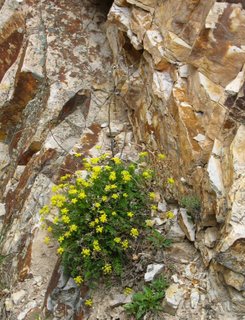
Right: Mountain Caraway, Aletes acaulis, occurs throughout the montane, but clearly is fond of rock walls, banks, edges, and other dramatic options.
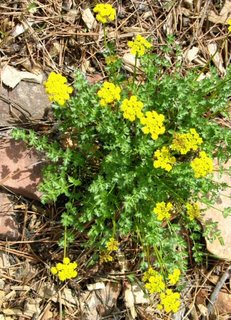
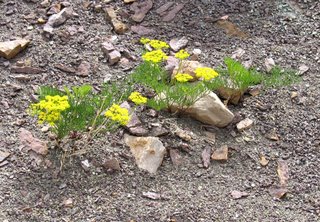 Right: Whiskbroom Parsley, Harbouria trachypleura, is also common in montane forests, and can be distinguished by its very narrow, finely divided leaves.
Right: Whiskbroom Parsley, Harbouria trachypleura, is also common in montane forests, and can be distinguished by its very narrow, finely divided leaves.
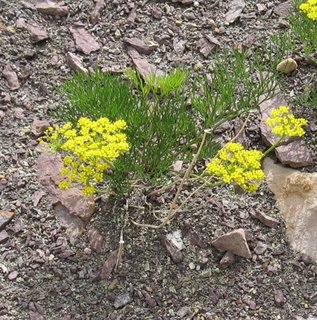 Montane forests, for those not around here, generally means forests mostly of either Ponderosa Pine or Douglas-Fir, at elevations from about 6,000 to 8,000 feet, with Ponderosa on the warmer or lower areas and Douglas-fir on cooler (e.g., north-facing) slopes. These plant communities mingle with shrublands (chaparral) on their lower edges and with dense coniferous forests of many species (but think spruce especially) at higher elevations. Okay?
Montane forests, for those not around here, generally means forests mostly of either Ponderosa Pine or Douglas-Fir, at elevations from about 6,000 to 8,000 feet, with Ponderosa on the warmer or lower areas and Douglas-fir on cooler (e.g., north-facing) slopes. These plant communities mingle with shrublands (chaparral) on their lower edges and with dense coniferous forests of many species (but think spruce especially) at higher elevations. Okay?
What's nice about the montane zone, among many fine qualities, is that it's rich in flowering shrubs and wildflowers of its own, as well as some refugees from lower elevations. We'll see some of those in the days ahead.
First up are two cousins: Whiskbroom Parsley and Mountain Caraway. In the deadly and delicious Carrot Family, these fall into the Rule 2 category: "don't pick, unless you really know what you're doing." But Rule 1, "don't pick" takes precedence in general anyway! Enjoy them and let them be.

Right: Mountain Caraway, Aletes acaulis, occurs throughout the montane, but clearly is fond of rock walls, banks, edges, and other dramatic options.

 Right: Whiskbroom Parsley, Harbouria trachypleura, is also common in montane forests, and can be distinguished by its very narrow, finely divided leaves.
Right: Whiskbroom Parsley, Harbouria trachypleura, is also common in montane forests, and can be distinguished by its very narrow, finely divided leaves. Montane forests, for those not around here, generally means forests mostly of either Ponderosa Pine or Douglas-Fir, at elevations from about 6,000 to 8,000 feet, with Ponderosa on the warmer or lower areas and Douglas-fir on cooler (e.g., north-facing) slopes. These plant communities mingle with shrublands (chaparral) on their lower edges and with dense coniferous forests of many species (but think spruce especially) at higher elevations. Okay?
Montane forests, for those not around here, generally means forests mostly of either Ponderosa Pine or Douglas-Fir, at elevations from about 6,000 to 8,000 feet, with Ponderosa on the warmer or lower areas and Douglas-fir on cooler (e.g., north-facing) slopes. These plant communities mingle with shrublands (chaparral) on their lower edges and with dense coniferous forests of many species (but think spruce especially) at higher elevations. Okay? What's nice about the montane zone, among many fine qualities, is that it's rich in flowering shrubs and wildflowers of its own, as well as some refugees from lower elevations. We'll see some of those in the days ahead.
Friday, May 05, 2006
The Usual View
Lost in fog this morning, though we do have a somewhat soggy visitor.
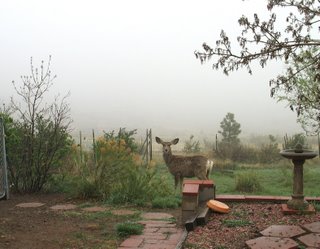 We first met "Baby Doe" in 1998. I remember, because it was a big year for apples and she came regularly to check out (and browse) our two trees and the many fine apples they produced that year.
We first met "Baby Doe" in 1998. I remember, because it was a big year for apples and she came regularly to check out (and browse) our two trees and the many fine apples they produced that year.
Then she discovered chicken food, and we haven't figured out how to keep it available to the chickens and inaccessible to her at the same time. Since we've known her, she's raised several sets of twins, partly on pilfered Purina.
I was going to say that we're lost in fog, but really, from my place-centric universe, it's the rest of the world that's disappeared. Nice cozy feeling-- no Denver, no Red Rocks even, out there. And HUMIDITY! Always a thrill in Colorado to feel moisture IN the air. Seems like years since we've had this kind of rainy, drippy May-- and it's most welcome.
 We first met "Baby Doe" in 1998. I remember, because it was a big year for apples and she came regularly to check out (and browse) our two trees and the many fine apples they produced that year.
We first met "Baby Doe" in 1998. I remember, because it was a big year for apples and she came regularly to check out (and browse) our two trees and the many fine apples they produced that year. Then she discovered chicken food, and we haven't figured out how to keep it available to the chickens and inaccessible to her at the same time. Since we've known her, she's raised several sets of twins, partly on pilfered Purina.
I was going to say that we're lost in fog, but really, from my place-centric universe, it's the rest of the world that's disappeared. Nice cozy feeling-- no Denver, no Red Rocks even, out there. And HUMIDITY! Always a thrill in Colorado to feel moisture IN the air. Seems like years since we've had this kind of rainy, drippy May-- and it's most welcome.
Thursday, May 04, 2006
She's Here!!
 At least I think she's a girl... or maybe an immature. If the black-headed grosbeaks come back, summer is not far away!
At least I think she's a girl... or maybe an immature. If the black-headed grosbeaks come back, summer is not far away!
 So far she's all alone-- and looked a little hungry! Hitting the sunflower seeds hard... She disappeared minutes later, so I was lucky to catch her. Soon they'll be regulars at the feeder.
So far she's all alone-- and looked a little hungry! Hitting the sunflower seeds hard... She disappeared minutes later, so I was lucky to catch her. Soon they'll be regulars at the feeder.
White-Crowned Sparrows
We have a small flock now of these little guys, but they've been camera-shy! Yesterday I was finally able to capture them, though with only moderate results.
 Aren't they cute? Like a little flock of chipmunks dashing around out there. Three white stripes and four black ones certainly give them a jaunty air.
Aren't they cute? Like a little flock of chipmunks dashing around out there. Three white stripes and four black ones certainly give them a jaunty air.
Still no sign of grosbeaks and orioles. Got to get out and look for wildflowers! Damp and drizzly today after some rain yesterday-- so it's great lichen weather too.
 Aren't they cute? Like a little flock of chipmunks dashing around out there. Three white stripes and four black ones certainly give them a jaunty air.
Aren't they cute? Like a little flock of chipmunks dashing around out there. Three white stripes and four black ones certainly give them a jaunty air.Still no sign of grosbeaks and orioles. Got to get out and look for wildflowers! Damp and drizzly today after some rain yesterday-- so it's great lichen weather too.
Wednesday, May 03, 2006
Wrong Again!
Juncos are still here after all. Their numbers are overwhelmed by the white-crowned sparrows, but yesterday there was definitely a gray-headed junco keeping me company while I sat outside. My informants tell me that they don't leave, they just migrate west to higher altitudes for the summer. And the bird book confirms that they do indeed breed here in the Rockies, the whole range just shifts a little west and north with the onset of warmer weather. Just shows I haven't been spending enough time in the mountains lately.
East-west migration is a pretty common phenomenon here in Colorado, where we can always find snow upstream if it gets too hot here in the lowlands. Contrariwise, the Stellar's jays often come down from Evergreen to visit when a winter storm threatens 10 miles up the canyon.
East-west migration is a pretty common phenomenon here in Colorado, where we can always find snow upstream if it gets too hot here in the lowlands. Contrariwise, the Stellar's jays often come down from Evergreen to visit when a winter storm threatens 10 miles up the canyon.
Tuesday, May 02, 2006
Spring is Here! For Real This Time...
Two absolutely beautiful, perfect days in a row. No snow even! Sunday night it actually rained, gave everything a brief but thorough soaking. Followed by more sunny days, but seasonally cool-- no immediate plunge into summer.
Artemis, "our" sharp-shinned hawk, breezed by this morning, a strafing run (or so the chickens thought it). She didn't stop for breakfast, or even pause. Just checking out her territory, evidently. And the juncos are gone. Takes longer to notice an absence, so I'm not sure exactly when they disappeared, but sometime in the last few days. Grosbeaks and orioles have, surprisingly, not shown up yet, but we're looking forward to their arrival. Only a few hummers are here so far.
Sand lilies (Leucocrinum) and Nuttall violets are blooming now, along with the ubiquitous salt-and-pepper (Lomatium). Will have to go check for more signs of spring. Husband and I did see a few pasque flowers on Earth Day, up the canyon at Dedisse Park in the ponderosa forest, where I was checking for my favorite ground lichen, a profusely branched Cladonia I've yet to pinpoint.
And that's all for today...
Artemis, "our" sharp-shinned hawk, breezed by this morning, a strafing run (or so the chickens thought it). She didn't stop for breakfast, or even pause. Just checking out her territory, evidently. And the juncos are gone. Takes longer to notice an absence, so I'm not sure exactly when they disappeared, but sometime in the last few days. Grosbeaks and orioles have, surprisingly, not shown up yet, but we're looking forward to their arrival. Only a few hummers are here so far.
Sand lilies (Leucocrinum) and Nuttall violets are blooming now, along with the ubiquitous salt-and-pepper (Lomatium). Will have to go check for more signs of spring. Husband and I did see a few pasque flowers on Earth Day, up the canyon at Dedisse Park in the ponderosa forest, where I was checking for my favorite ground lichen, a profusely branched Cladonia I've yet to pinpoint.
And that's all for today...
Subscribe to:
Posts (Atom)


